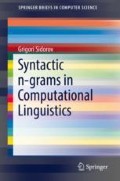Abstract
In recent years, a novel paradigm appeared related to application of neural networks to any tasks related to artificial intelligence [59], in particular, in natural language processing [39]. It became extremely popular in NLP area after works of Mikolov et al. starting in 2013 [74, 75]. The main idea of this paradigm is to apply neural networks for automatic learning of relevant features with various levels of generalization in vector space model. Sometimes this model of representation of objects is called continuous vector space model. In general, this paradigm is called “deep learning.”
Access this chapter
Tax calculation will be finalised at checkout
Purchases are for personal use only
Bibliography
Firth, J.R.: A Synopsis of Linguistic Theory. In: Palmer, F.R. (ed), (1968) Selected Papers of J.R. Firth 1952-59. London/Harlow: Longmans (1957)
Goldberg, Y: A Primer on Neural Network Models for Natural Language Processing. Journal of Artificial Intelligence Research 57:345–420 (2016)
Hinton, G.E., Srivastava, N., Krizhevsky, A., Sutskever, I., Salakhutdinov, R.R.: Improving neural networks by preventing co-adaptation of feature detectors. arXiv:1207.0580 (2012)
LeCun, Y., Bengio, Y., Hinton, G.: Deep learning. Nature, Vol. 521, 436–445 (2015)
LeCun, Y., Bottou, L., Orr, G., Muller, K.: Efficient BackProp. In: Neural Networks: Tricks of the trade. Springer (1998)
Mikolov, T., Chen, K., Corrado, G., Dean, J.: Efficient Estimation of Word Representations in Vector Space. arXiv:1301.3781 (2013)
Mikolov, T., Sutskever, I., Chen, K., Corrado, G.S., Dean, J.: Distributed Representations of Words and Phrases and their Compositionality. In: Burges, C.J.C., Bottou, L., Welling, M., Ghahramani, Z., Weinberger, K.Q. (Eds.), Advances in Neural Information Processing Systems 26, pp. 3111–3119 (2013)
Author information
Authors and Affiliations
Rights and permissions
Copyright information
© 2019 The Author(s), under exclusive licence to Springer Nature Switzerland AG
About this chapter
Cite this chapter
Sidorov, G. (2019). Deep Learning and Vector Space Model. In: Syntactic n-grams in Computational Linguistics. SpringerBriefs in Computer Science. Springer, Cham. https://doi.org/10.1007/978-3-030-14771-6_7
Download citation
DOI: https://doi.org/10.1007/978-3-030-14771-6_7
Published:
Publisher Name: Springer, Cham
Print ISBN: 978-3-030-14770-9
Online ISBN: 978-3-030-14771-6
eBook Packages: Computer ScienceComputer Science (R0)

